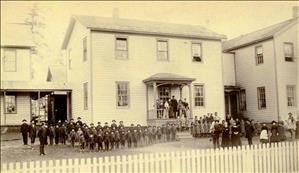On July 1, 1920, the Cushman Indian School (formerly known as the Puyallup Indian School), which has educated Native American children for six decades, officially closes its doors. The school, located on the Puyallup Indian Reservation in Tacoma, has focused on assimilating Native students through Western-based education. Opening in 1860, with expansions taking place in 1873 and 1898, the school primarily served the Puyallup Tribe but expanded its outreach to include various other local tribes. It has been a part of the concentrated efforts made at the time by federal and state governments to assimilate the Native American population into the dominant cultural and ideological frameworks of American society.
Education with an Agenda
From its opening, the Puyallup Indian School provided a standard -- often substandard -- education in reading, writing, math, and science, but it existed primarily as an extension of the American government's continuing efforts to assimilate Native Americans into the dominant American culture. Many members of the Puyallup Tribe along with other Native Americans from various tribes attended.
Prominent Puyallup Tribal member Henry Sicade (1866-1938) was one of them, attending the school when he was young. What he experienced there would stay with him, contributing to his lifelong desire to give his people opportunities to obtain an adequate education, better than was generally available in the federally operated schools. He and others bore witness to a lack of supplies, an inadequate facility, and incompetent teaching, all of which led him and other students to seek educational pathways elsewhere. Despite these deficiencies, the school continued operating for decades.
A Public Alternative
After his father's death in 1879, Sicade completed his education in Oregon. When he returned, he established himself as a prominent citizen in the Puyallup Tribe and in the Tacoma area. As the quality of the school continued to be substandard, in 1903 Sicade took it upon himself, with his friend William Henry Wilton (1862-1937), also a Puyallup Tribal member, to start an alternative -- a public school in Fife. The public school was a great success, with many Puyallup Tribe members attending along with other students, growing its popularity and outreach. Its reputation for high academic standards and high attendance led the public school to expand from a one-room classroom to a two-story building in just three years. Sicade viewed it as a more proper, fulfilling, and ultimately more successful route for Native Americans to become educated in Western ways.
The popularity of Fife's public school significantly affected attendance at the Puyallup Indian School, and in 1908 the Office of Indian Affairs decided to shut down the Indian school. Francis Cushman (1867-1909), a Republican congressman from Tacoma, stepped in to save it. He promoted it as a viable economic benefit to the surrounding community, arguing that the city needed a place where curious visitors could go to see Indians. In 1910, following Cushman's death, the Puyallup Indian School was renamed as the Cushman Indian School in his honor.
Trying a New Curriculum
The federal government stepped in to transform the newly renamed school toward a more industrial-based training curriculum rather than a traditional academic course offering. This approach failed to stem transfers to public school, leading the Cushman Indian School into a tumultuous period during which its existence was continually in question. In 1917, the school closed temporarily due to a lack of funding. (The school had previously closed temporarily in 1875 because it lacked food.)
As the early stages of political and social measures for Native American self-determination began to come to fruition during this period, the Cushman school's challenges became increasingly difficult to navigate. In June 1920, the Bureau of Indian Affairs decided to permanently close the Cushman Indian School after the fiscal year concluded, and local public schooling became the predominant form of educating Native American youth in the ways and customs of the dominant American society in the state.

